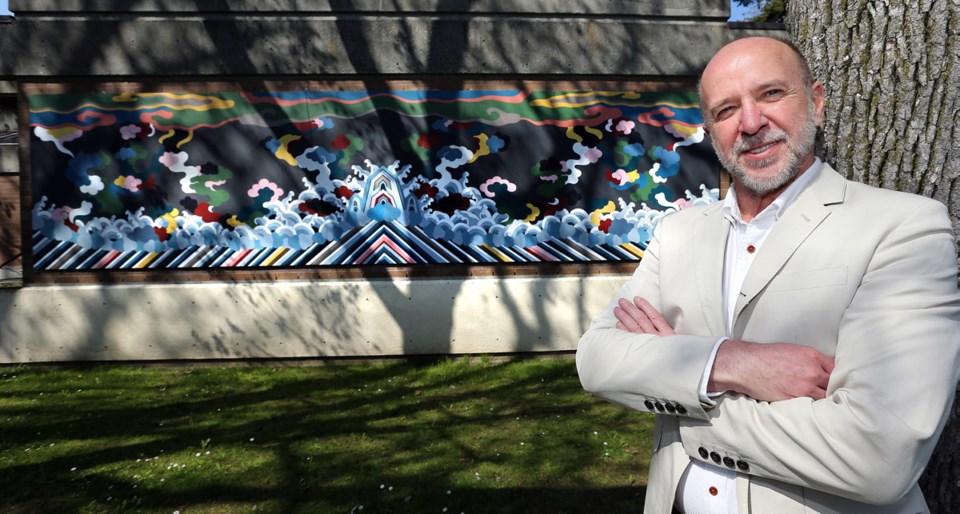 Jon Tupper has a Vespa scooter, skinny jeans and outrageous socks. He makes the scene all over Victoria. He’s candid and charming and, for five years, has been the director of the Art Gallery of Greater Victoria. I recently sat down with him, to talk over the workings of the gallery.
Jon Tupper has a Vespa scooter, skinny jeans and outrageous socks. He makes the scene all over Victoria. He’s candid and charming and, for five years, has been the director of the Art Gallery of Greater Victoria. I recently sat down with him, to talk over the workings of the gallery.
The Art Gallery of Greater Victoria began as a volunteer organization in the late 1940s. When Colin Graham came as the first professional staff member in 1953, “he coaxed if from being a volunteer to a professional organization,” Tupper told me. “That can be a difficult situation, when the volunteers feel they are no longer needed. It can create bad feelings, but Colin brought them along.”
The gallery is not a branch of the government, like the Royal B.C. Museum and Archives. And it is not affiliated with an education institution, like the University of Victoria’s Legacy Gallery and the Maltwood Museum and Art Gallery. The Gallery started out very “grass roots.” Then, in the mid-50s, the federal government determined that Canadians wanted their arts and culture to be sponsored by the government, rather than private corporations as in the U. S.
During the 1970s, federal support grew as the Canada Council and National Exhibition Centres were developed. “The gallery was funded consistently in the mid-80s, but then the arts and culture became a convenient way to cut back,” Tupper acknowledged. “It’s been a struggle ever since, trying to get our feet under ourselves.”
The gallery is governed by an elected board of directors. “They are overseeing the organization, but they are not meddling in our affairs,” Tupper told me. “They keep the train on the track, but they’re not driving the train. They provide oversight. They are a good board. I’m proud of them. They’re very dedicated, and all of them are donors to the gallery — they really put their money where their mouth is.”
The Associates, originally known as the Women’s Committee and later the Volunteer Committee, are key to this institution’s relationship to the community. In the past they staffed the shop, the café and, says Tupper, “basically built the gallery.” Then for a few years they were rather ignored, but now they are thriving. They really enjoy what they do. And “they fundraise about $40,000 in cash money every year,” Tupper said. “And what the members donate individually is much more than.”
Beginning with art groups for pre-schoolers, the gallery programs outreach to children in high school and middle school. At one time graffiti became a common occurrence on the front wall of the building, but, as Tupper explained, “the point of graffiti is to make an ugly place beautiful.” So they hired a graffiti artist to teach kids how to do “good” graffiti. Rick Leong recently painted the hem of a Chinese robe there, an image that relates to what’s inside of the building. Tupper told me that “more and more contemporary artists are coming in, wanting to see elements of the collection.”
Urbanite, and Jazz at the Mansion each attract another slice of the demographic. “One quarter of our membership is youth,” he mused. “For these successful events, we are fortunate to have our own home. We can invite people here for a party, and we can do it with pride.”
The gallery began chasing opportunities for a downtown home in the 1980s. “It didn’t happen,” Tupper said. “This is our home. We can be excellent here. Garry oaks, Craigdarroch Castle, Wentworth Villa, Langham Court Theatre, Government House gardens — this is the culture quadrant. Tourists, who make up just 25 per cent of our audience, will find us — when they leave home they already know where the gallery is. They don’t need to stumble across it. We subsidize tourists,” he underlined. “The admission cost is $13, but the real cost is about $33 per visit.” Where is that coming from? “Donors, government, our own self-generated revenue.”
Tupper says the gallery will always design its exhibits on the local experience. “We should be focused on our community first … and tourists love that.” He then paid homage to the feature which makes this gallery stand out — its fabulously rich Asian collection. In the future, he sees improved storage space and exhibit space but foremost in renewal plans is the public side — space for meetings, lectures, teaching, and the co-ordination of the physical plant with grounds. “The Asian garden — we need to make more of a fuss about that,” he went on. “We should have a café. We’ve never had a meeting room. When the Associates meet, we are at maximum capacity already.”
Admittedly, these dreams are a $21-million project, “and until we get a clear idea from the government, there is no sense in going to the public. We’ve had a bunch of false starts in the past. If we get commitments … then it will happen,” the director noted. Some very promising private donations are already in hand. “It’s not a great time to be going to governments for money,” he observed, “but it never is a good time. We’re close in negotiations. We’re doing everything right.” Patient and pragmatic as ever, Tupper said “I’ve met with about 27 provincial MLAs, and every one — to a person — has been supportive of this gallery and its aspirations. They like what we are doing.”
With its collection of 18,000 artworks, a building they own in a pleasant location, an enthusiastic board and motivated staff working under a personable director, what’s not to like? You could become a member.



